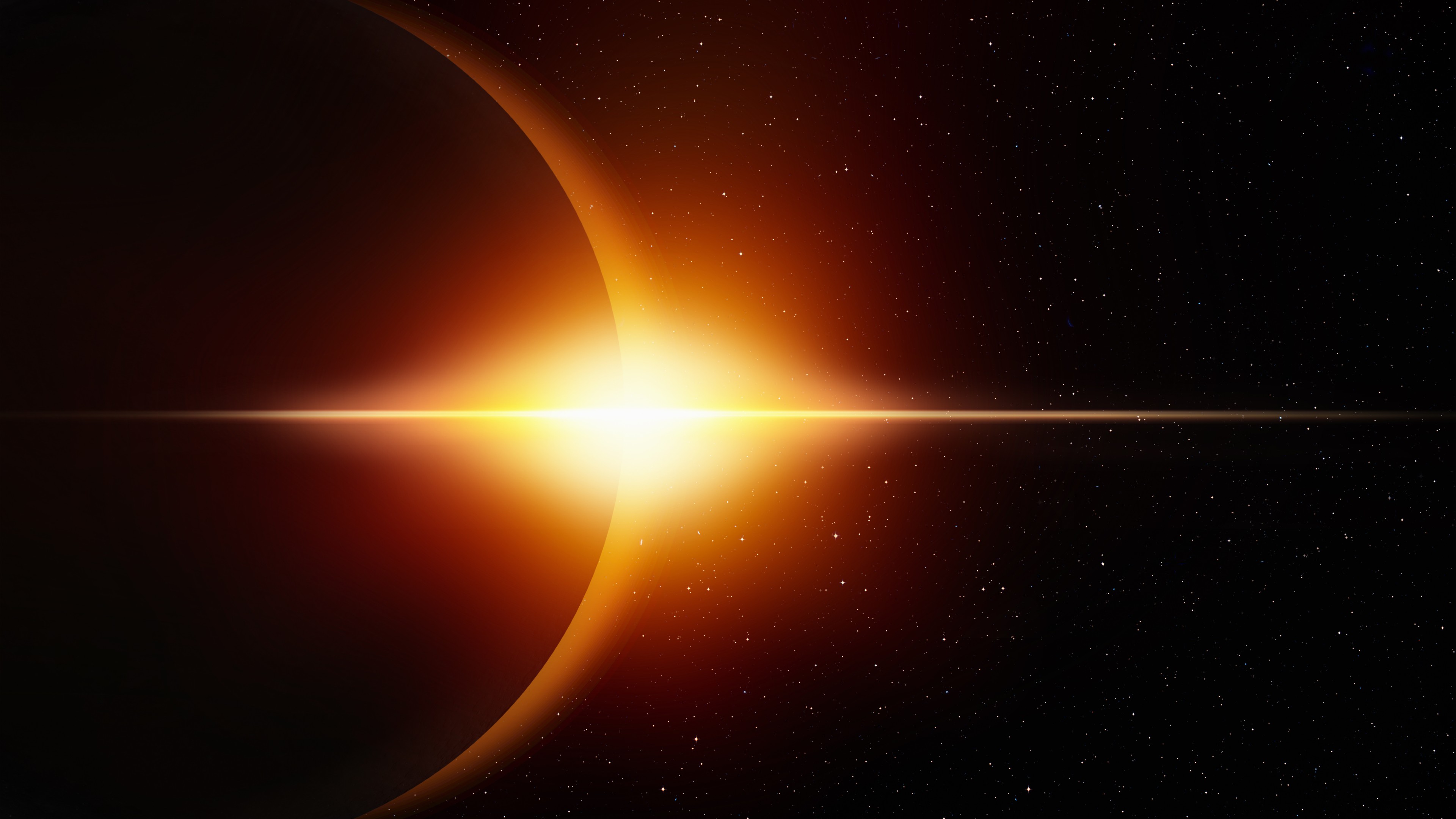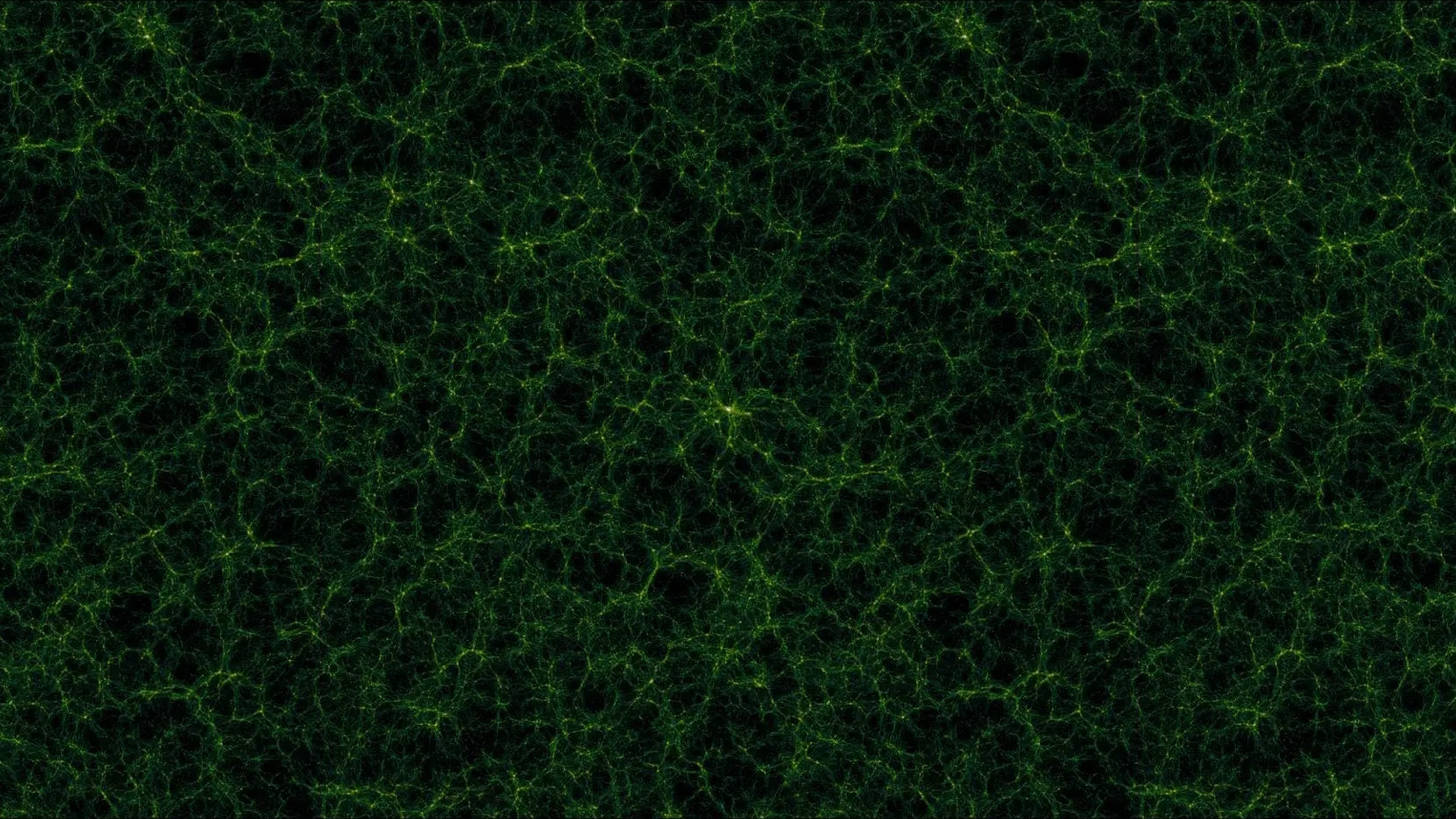Throwback Thursday: The greatest supernovae that no one saw
There have been many supernovae in the Milky Way seen over the past 2,000 years, but nobody ever saw the most recent ones!
Image credit: NASA/CXC/NCSU/K.Borkowski et al.
“When I had satisfied myself that no star of that kind had ever shone before, I was led into such perplexity by the unbelievability of the thing that I began to doubt the faith of my own eyes.” –Tycho Brahe
When we look out at galaxies throughout the Universe, we find that every so often — about once per century — a bright star flares up so brightly that it can, for a brief amount of time, outshine the entire rest of the galaxy!
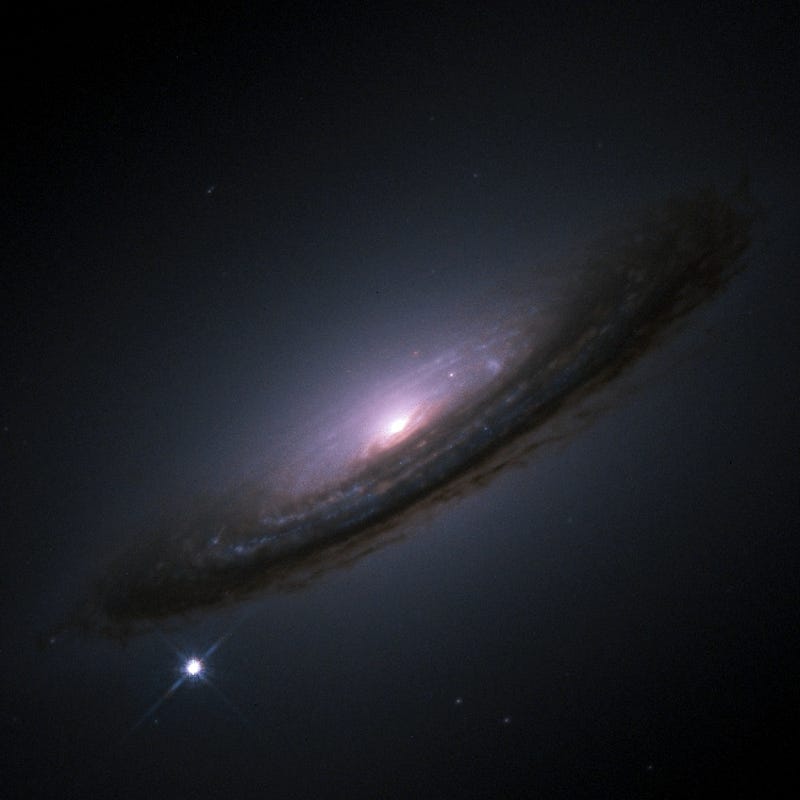
What’s going on, of course, is not that a star is brightening, but that the very atoms composing a star are undergoing a runaway chain reaction of nuclear fusion, creating the infamous phenomenon known as a supernova!
In perhaps one of the worst strokes of luck, we haven’t seen a supernova go off in our own galaxy since the invention of the telescope! The last one, in fact, went off in 1604, and has long since faded from view. (The famous one from 1987? That was in the Large Magellanic Cloud, a satellite galaxy some 160,000 light-years distant.) But thankfully, it isn’t just in visible light that we can learn about these objects: we can turn a myriad of telescopes sensitive to different wavelengths at the regions of sky where these supernovae were recorded, and see what they look like today!
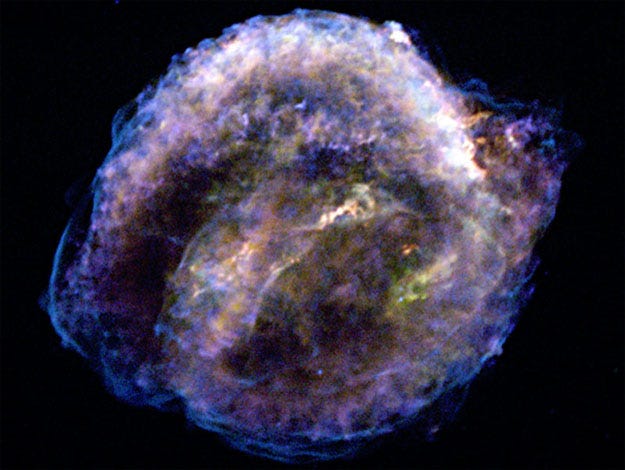
The 1604 supernova was the last one visible from Earth with a human’s naked eye, and is shown above in a composite of visible light, X-rays, and infrared. We know, from the lack of a strong X-ray source (neutron star or black hole) at the center, that this explosion was probably a Type Ia, where a white dwarf star either merges or accrues enough matter and undergoes a runaway fusion reaction, destroying the original star (or stars) in a spectacular supernova event!
Same deal, as far as supernova type, for the one prior to that (and it was really just prior): SN 1572.
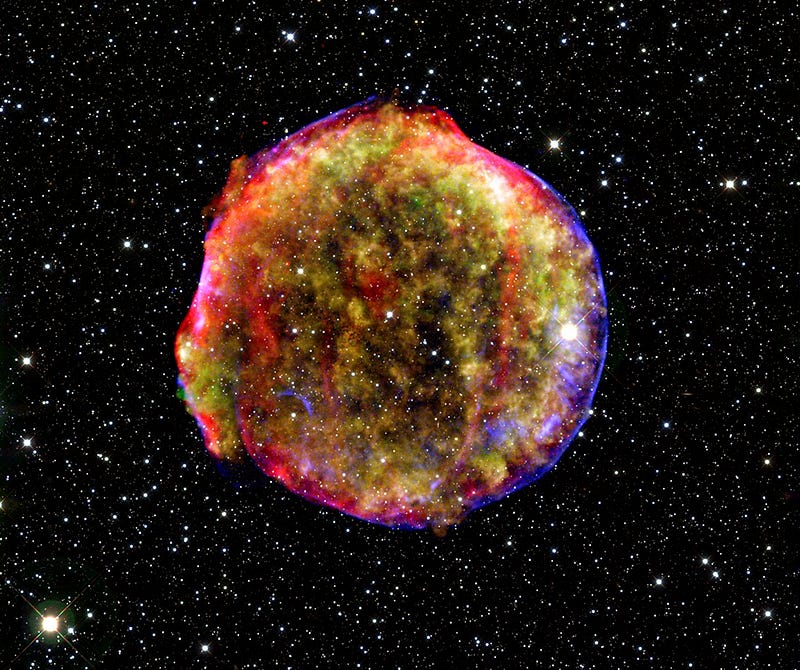
Although it was brilliant back in 1572, a lot has changed since then. Today, it’s visually not-so-spectacular in visible light, but the ultra-hot remnants of the exploded star have been blown off into interstellar space at breakneck speeds of thousands of kilometers per second, and are so hot that they emit X-rays! There’s also dust, present throughout the galaxy, which gets heated by the supernova explosion; that’s what glows in the infrared.
The last supernova that we saw on Earth before that? You have to go all the way back to 1181, and we still aren’t sure we found the remnant from that. Below is the suspected candidate: 3C58.
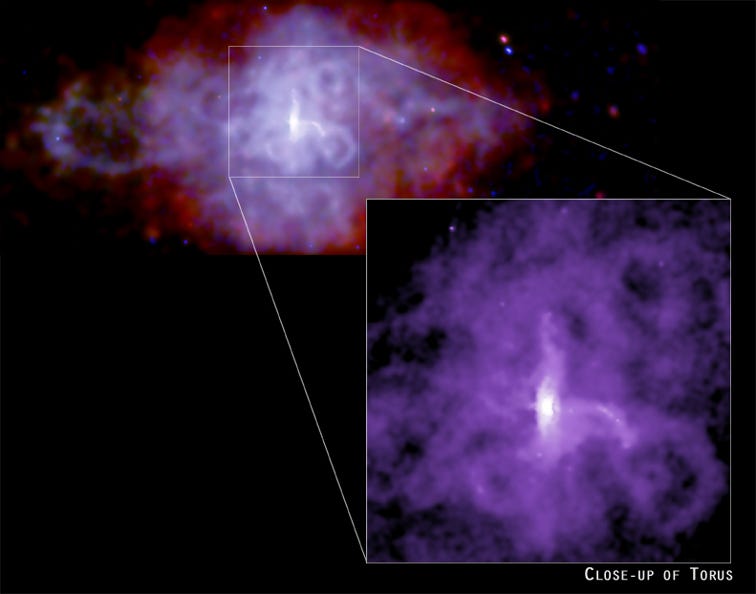
But we’ve definitely found the supernova remnant observed prior to that: SN 1054. And is it ever different than all the others we’ve looked at so far!
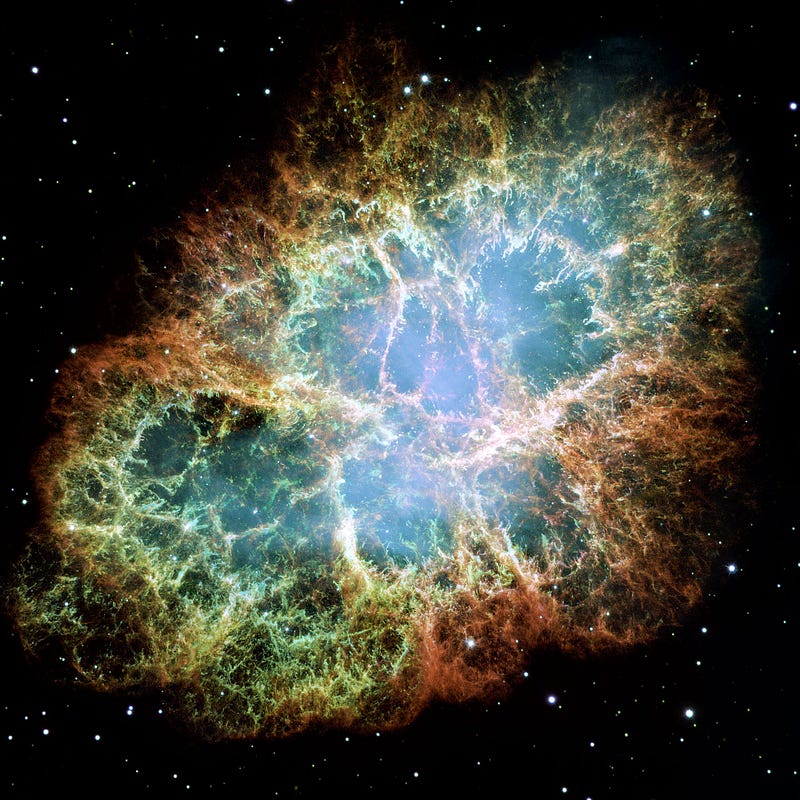
This supernova remnant, as you will immediately notice, looks nothing like the ones from 1604 or 1572, and for a good reason: it’s an entirely different type of supernova! The famed Crab Nebula, also known as Messier 1, wasn’t formed by a white dwarf getting too massive, but rather by an ultra-massive star burning through all of its nuclear fuel and dying in a core collapse supernova, blowing off tens of solar masses worth of material!
The collapsed core of this star has created a pulsar, one of the most spectacularly accurate clocks in the Universe, and bettered for timekeeping purposes only by our atomic clocks on Earth!
Prior to that, there was the brightest supernova ever recorded on Earth: the one of 1006.

By this point, you should be able to tell that this was once a white dwarf and not a supermassive star, and you’d be correct! After 1,000 years, the “bubble” produced by this explosion is actually more than four light years in diameter, and if it were our star that exploded like this, the edge of the bubble would be halfway to Alpha Centauri by now!
Prior to 1006? There was one in 393 that we may have found, one claimed to have been found in 386 that probably wasn’t, and the oldest supernova ever recorded (and verified): Supernova 185!
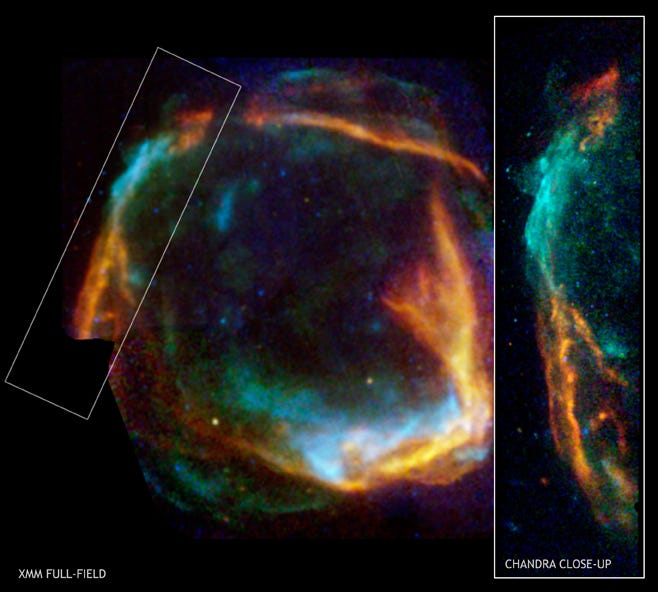
These latter three were only found in Chinese (and Japanese) records; no western sources recorded them at all. And just from looking at the X-ray image, 2000 years later, you can tell this was a white dwarf that exploded, and not an ultra-massive star.
But looking at these images got me curious: how much fun would it be to take a look at these supernova remnants in visible light only, like watching snapshots from a slow-motion cosmic fireworks show? Let’s go to the pictures!
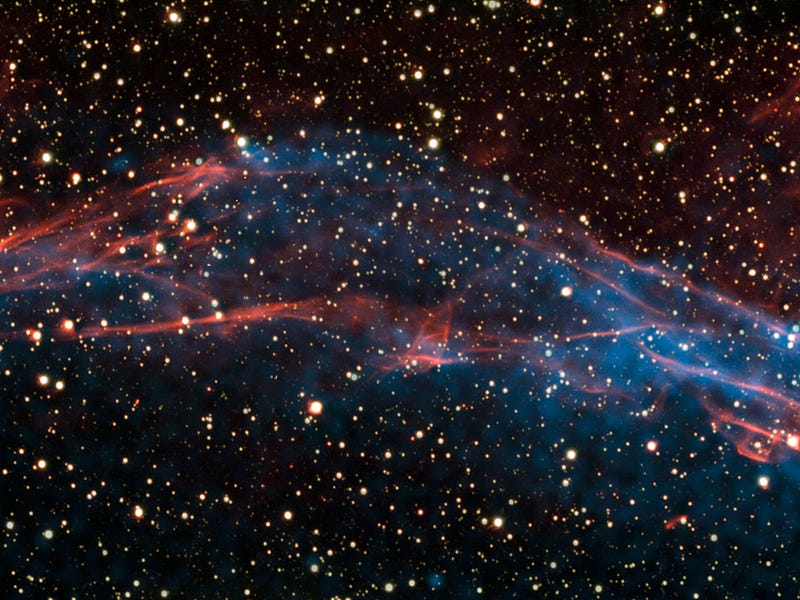
If you’re wondering why I’m only showing you a tiny portion of what you expected to be a circular or spherical wave, it’s because this is the only luminous part! From nearly 2000 years ago, the supernova remnant RCW 86 (from the 185 supernova) still has a small section of the outer “bubble” visible in visible light, as shown in red, above. Like the very end stages of a fireworks display, this is the last bit that would be visible with unmodified human eyes. (The blue is shocked X-ray gas.)
You might think that it was once a visible sphere, then. But that’s looking quite unlikely; apparently, a thousand years doesn’t necessarily change things all that much.
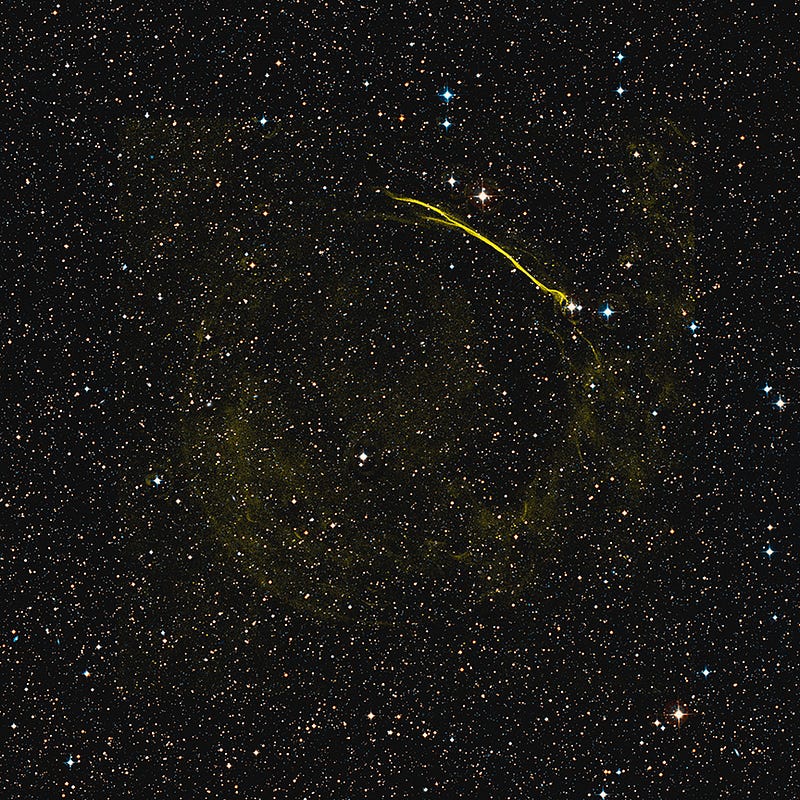
The 1006 supernova is nearly invisible in optical light, save for a thin ribbon and some very faint gas along the outer shell. (And, of course, all the stars visible in the image, too!) But the 1054 supernova, the only one we talked about as being a remnant from a supermassive star instead of from a degenerate white dwarf (that’s not a snark; they really are degenerate), has an entirely different story to tell.
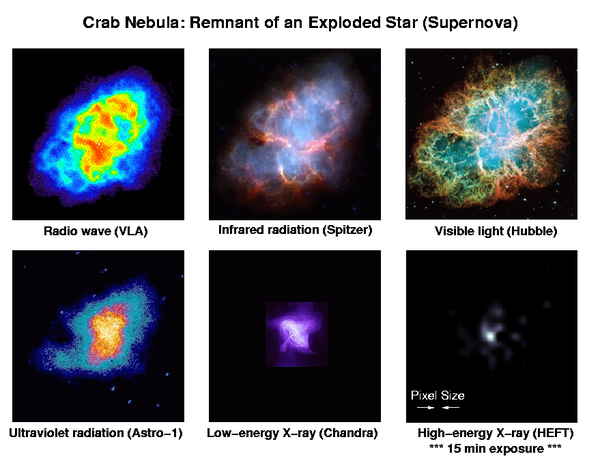
That gorgeous image of the Crab Nebula I showed you earlier? That was entirely a visible light image! The outer layers of gas, rich in some of the lighter heavy elements — oxygen, carbon, nitrogen — create some beautiful, contrasting colors in the nebula as they get superheated and strewn across interstellar space.
But there’s a very rich story to be told in a myriad of wavelengths, as you can clearly see, from the bright X-ray source at the core to the warm dust traced out by the infrared telescopes. Visible light still tells a rich story for the Crab Nebula because of the sheer amount of gas and dust, as well as the energy that was released into it.
The 1572 supernova, with almost no gas and dust, tells a very different story.

Sure, they found the leftover, Sun-like star that got blasted by its companion which went supernova nearly 500 years ago, but visible fireworks? Not a trace.
So there actually is some variety here after all, and this is well-exemplified by the last supernova seen in visible light by humans here on Earth: the 1604 supernova.
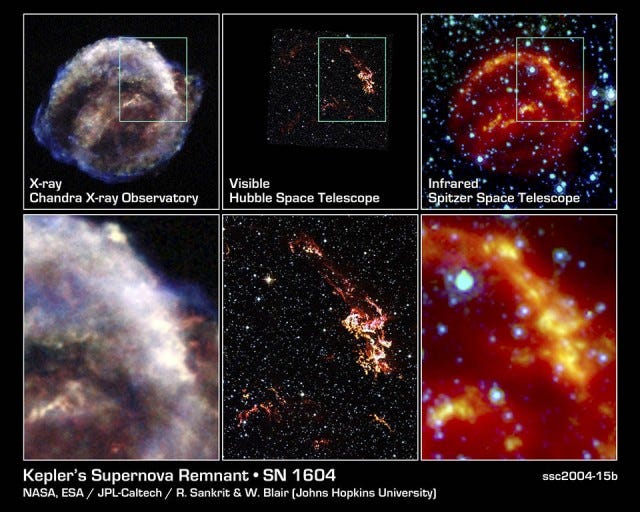
Not a bubble or a ribbon, but just a small region of the remnant contains some visibly glowing gas. The infrared is particularly interesting, above, because that indicates the presence of dust that’s gotten heated. And dust is fantastic for doing a number of interesting things, but horrible for the same reason: it blocks visible light.
It seems like the one thing that’s missing — that I’d want to know about, anyway — is a supermassive explosion where that hot, visible dust were somehow stripped away. What would that look like?
Well, there weren’t any naked-eye supernova that have occurred in our galaxy since 1604, unfortunately. But in the late 17th Century, there was a supernova that occurred, and while its remnant is very faint optically, it happens to be the single loudest radio source in our galaxy: Cassiopeia A!
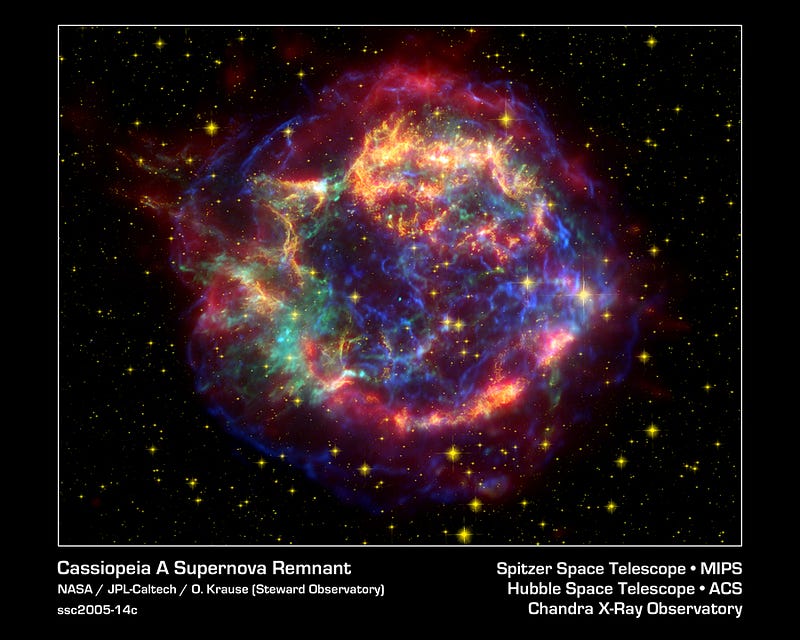
Located an estimated 11,000 light years away, this supernova remnant is already over 10 light years across, making it significantly larger than the Crab Nebula, but having gotten there in just a third of the time! Since it’s home to the strongest radio source in our galaxy, there must be either a fantastic neutron star or a black hole (and it’s probably a black hole) at the center.
But today, let’s take a look at the fireworks, something that we’ve been able to reconstruct.
But why settle for a simulated reconstruction when you can have a look at the real thing — what’s actually left — in the optical itself?
The incomparable Hubble Space Telescope has an amazing, long-exposure photograph of the visible light left behind from this supernova explosion, which you have got to see, because it truly shows you why I call these explosions “cosmic fireworks.”
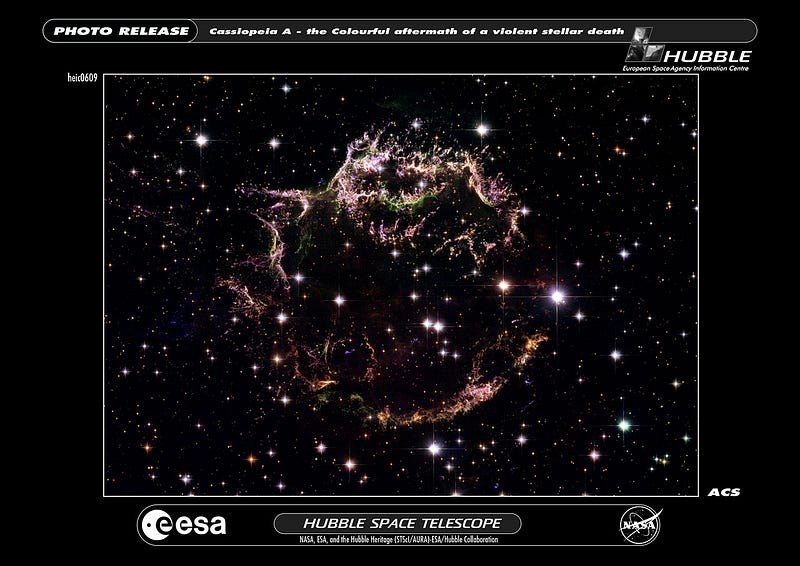
This would have been visible from Earth — occurring some 11,000 light-years away — if it weren’t in the plane of our Milky Way, obscured by the intervening galactic dust that blocks a significant fraction of the light coming from it. It’s only thanks to long-exposures like the above, taken from space, that we can “see” the aftermath of what happened.
And what I’ve shown you above is just a stripped-down version of an amazing full-resolution showpiece! Here’s just a tiny section of it, and even this is at a significantly reduced resolution:
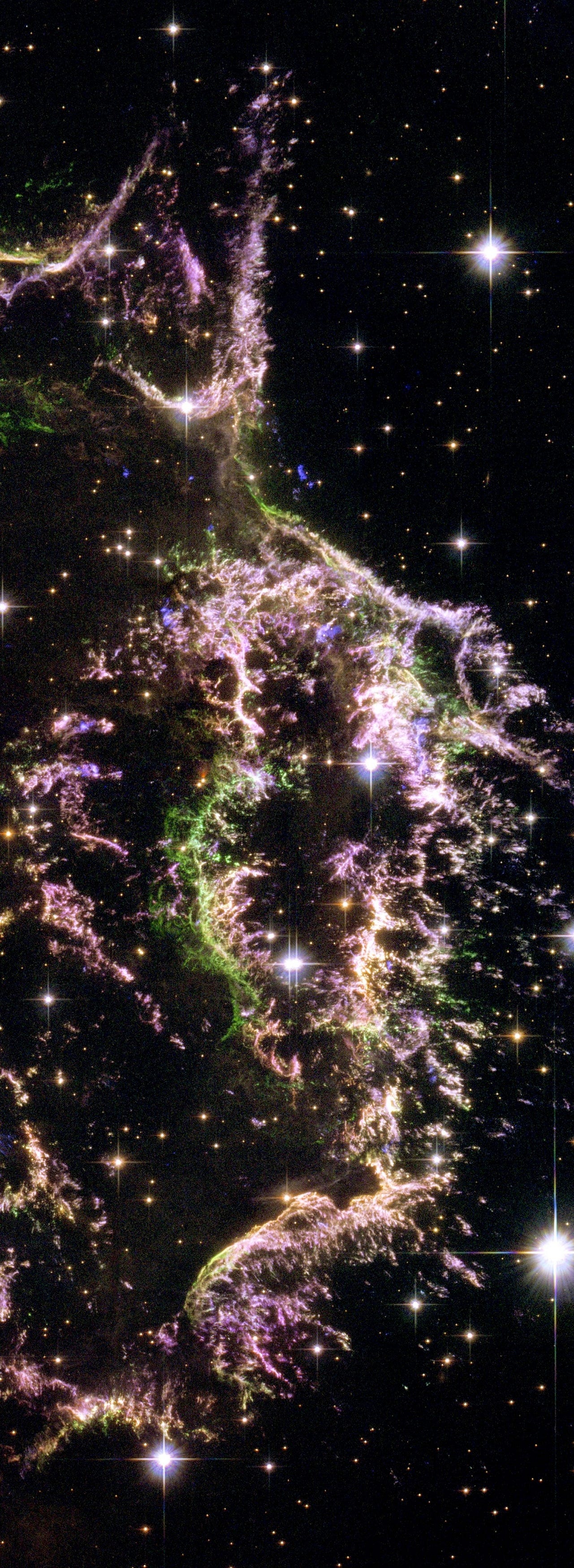
For a long time, we thought this event, estimated to have occurred in 1680, was the Milky Way’s most recent supernova. But remember the following:
- We’re some 25,000 light-years from the galactic center,
- Supernovae occur about once-per-century in galaxies,
- We haven’t seen a supernova since 1604, and
- We were able to find one only 11,000 light-years away that occurred since that 1604 event.
Are there others that occurred since 1680? Up until relatively recently, we would have said “quite possibly,” but we wouldn’t have been sure.
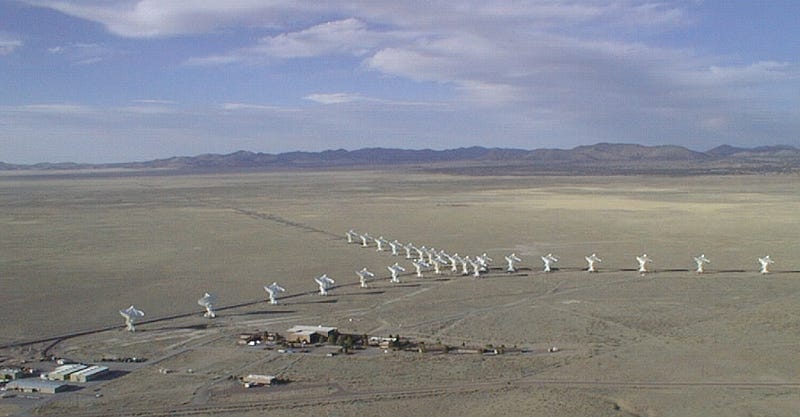
But thanks to observations made with the Very Large Array radio telescopes in 1984, we’ve got one for sure! If you were wondering what that image at the very top of this article was, that’s the newest supernova remnant in the Milky Way galaxy (right now): G1.9+03 in the constellation of Sagittarius!
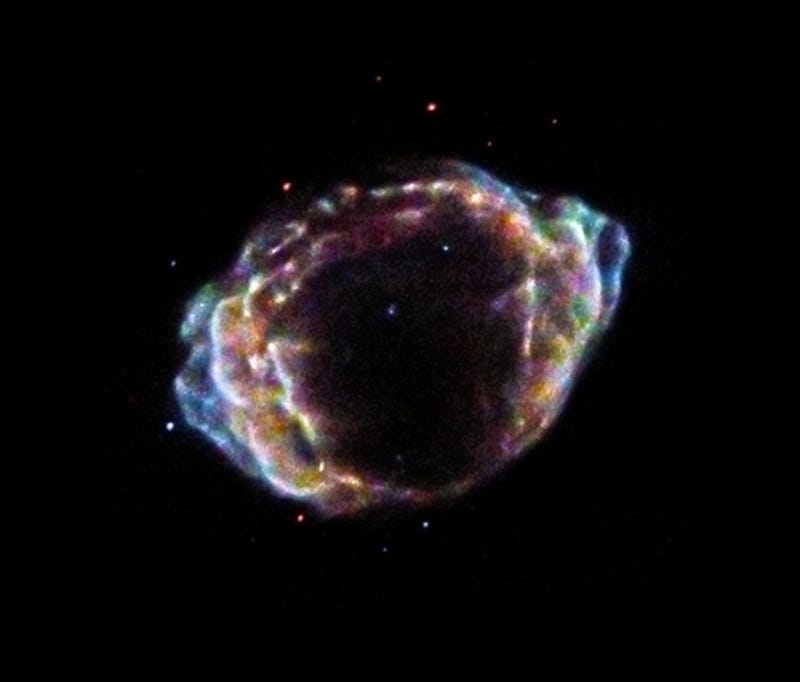
Occurring approximately in the 1860s, this is (clearly) a Type Ia supernova remnant, originating from a white dwarf star, but it occurred near the galactic center some 25,000 light-years away. All that light-blocking dust would have made it impossible to view optically even with the Leviathan telescope, the largest in the world at the time. Even in this short time, the remnant has expanded to be about 2.6 light years in diameter, and observations from Chandra in 2007 found that it was 15% larger than it was back in 1984 when the VLA discovered it!
That’s the story of the Milky Way’s greatest supernova that nobody ever saw, but chew on this: there are probably hundreds of others that have gone off in our galaxy over the past few tens of thousands of years, and we’re simply waiting for the light of the explosions to reach us! It’s only a matter of time before the next one illuminates our skies and — if we’re lucky — shows itself to our naked eyes!
Leave your comments at the Starts With A Bang forum on Scienceblogs!
